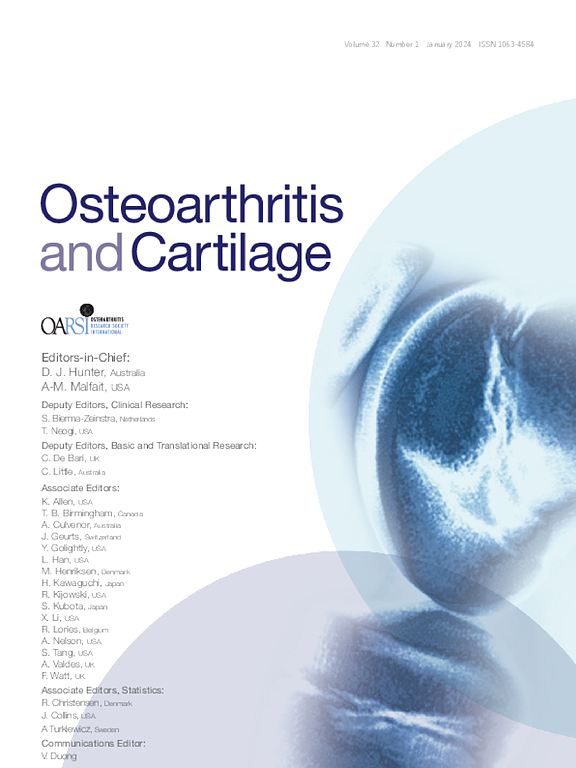反向遗传学追踪人类软骨细胞的分化途径。
IF 7.2
2区 医学
Q1 ORTHOPEDICS
引用次数: 0
摘要
目的:通过强制表达山中重编程因子,哺乳动物体细胞可重编程为诱导多能干细胞(iPSC)。然而,只有少数通过特定途径的细胞能蜕变为 iPSC,而其他细胞则不能。本研究旨在阐明软骨细胞在重编程过程中所遵循的途径:设计:我们通过时间序列单细胞转录组分析(我们称之为反向遗传方法)研究了人类关节软骨细胞在重编程过程中的命运。我们还采用了 iPS 干扰技术来验证软骨细胞在经过适当的分化途径后是否会反向恢复多能性:结果:我们证实人类软骨细胞可转化为具有 iPSC 表型的细胞。结果:我们证实,人类软骨细胞可转化为具有 iPSC 表型的细胞。此外,我们还发现,在适当的转录组转换途径中,有限的细胞群在特定的点上沉默了软骨形成的主基因 SOX9,最终可成为 iPSC。有趣的是,其他未能被重编程的细胞则以一种独特的途径走向具有表面区软骨细胞表型的细胞。研究表明,细胞通讯网络因子(CCNs)在这一过程中发挥了关键作用。使用 SOX9 成功干扰 iPS,支持了软骨细胞在重编程为 iPSCs 时遵循向后分化途径的观点:这种反向遗传策略可能有助于寻找各种体细胞分化主基因的候选者。CCNs 在关节软骨再生中的实用性也得到了支持。本文章由计算机程序翻译,如有差异,请以英文原文为准。
Inverse genetics tracing the differentiation pathway of human chondrocytes
Objective
Mammalian somatic cells can be reprogrammed into induced pluripotent stem cells (iPSCs) via the forced expression of Yamanaka reprogramming factors. However, only a limited population of the cells that pass through a particular pathway can metamorphose into iPSCs, while the others do not. This study aimed to clarify the pathways that chondrocytes follow during the reprogramming process.
Design
The fate of human articular chondrocytes under reprogramming was investigated through a time-coursed single-cell transcriptomic analysis, which we termed an inverse genetic approach. The iPS interference technique was also employed to verify that chondrocytes inversely return to pluripotency following the proper differentiation pathway.
Results
We confirmed that human chondrocytes could be converted into cells with an iPSC phenotype. Moreover, it was clarified that a limited population that underwent the silencing of SOX9, a master gene for chondrogenesis, at a specific point during the proper transcriptome transition pathway, could eventually become iPSCs. Interestingly, the other cells, which failed to be reprogrammed, followed a distinct pathway toward cells with a surface zone chondrocyte phenotype. The critical involvement of cellular communication network factors (CCNs) in this process was indicated. The idea that chondrocytes, when reprogrammed into iPSCs, follow the differentiation pathway backward was supported by the successful iPS interference using SOX9.
Conclusions
This inverse genetic strategy may be useful for seeking candidates for the master genes for the differentiation of various somatic cells. The utility of CCNs in articular cartilage regeneration is also supported.
求助全文
通过发布文献求助,成功后即可免费获取论文全文。
去求助
来源期刊

Osteoarthritis and Cartilage
医学-风湿病学
CiteScore
11.70
自引率
7.10%
发文量
802
审稿时长
52 days
期刊介绍:
Osteoarthritis and Cartilage is the official journal of the Osteoarthritis Research Society International.
It is an international, multidisciplinary journal that disseminates information for the many kinds of specialists and practitioners concerned with osteoarthritis.
 求助内容:
求助内容: 应助结果提醒方式:
应助结果提醒方式:


